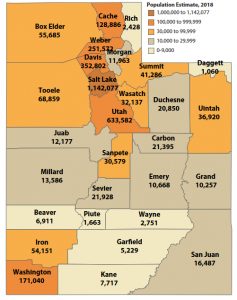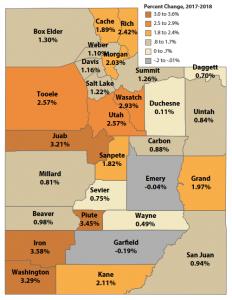Blog Post
Insight: New population estimates show state growth slowing for first time since 2013
By: Emily Harris
The Utah Population Committee (UPC) convenes an annual meeting every fall to discuss, review, and vote on the newest state and county population estimates. These estimates include total population, births, deaths, natural increase (births minus deaths), and net migration for each county and the state. Utah’s growth accelerated between 2014 and 2017, even claiming the Census Bureau’s title as the fastest growing state in the nation in 2016.
The July 1, 2018 estimates indicate that Utah’s growth, while still high, is starting to decelerate. Last year, Utah grew by 1.9 percent (58,989 people) and this year by 1.7 percent (52,644 people). Utah’s natural increase and net migration, the two components of population change, also decreased from 2017 to 2018, but are still relatively high. Utah’s births are at their lowest level since 2000, but still maintains the second highest fertility rate in the nation (behind South Dakota). As Utah’s population begins to age, the number of annual deaths increases. Coupling that with declining births produces a lower natural increase each year. These trends are apparent nationally.
Total Population and Annual Percentage Change in County Population


Population estimates show much more variety within the state at the county level (see Maps above). Most of Utah’s counties experienced growth this year, but Iron, Piute, Washington, and Juab counties showed the highest annual percentage growth at 3 percent or higher. This year, Utah County showed the highest absolute growth in the state at 15,847, surpassing Salt Lake County by 2,041. The Wasatch Front and surrounding counties continue to grow, and show no signs of slowing. On the other hand, Garfield and Emery counties showed slight population declines, Emery due to net out-migration, and Garfield due to natural decrease.
Visit the state and county estimates page to learn more about Utah and its counties. You can access the 2018 State and County Estimates Summary Report, downloadable data from 2010 through 2018, and interactive data visualizations. The full research brief for state and county populations is now available online.
Emily Harris is a demographic analyst at the Kem C. Gardner Policy Institute.






